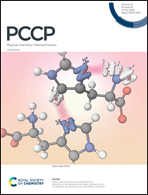Comparative electron irradiations of amorphous and crystalline astrophysical ice analogues
Abstract
Laboratory studies of the radiation chemistry occurring in astrophysical ices have demonstrated the dependence of this chemistry on a number of experimental parameters. One experimental parameter which has received significantly less attention is that of the phase of the solid ice under investigation. In this present study, we have performed systematic 2 keV electron irradiations of the amorphous and crystalline phases of pure CH3OH and N2O astrophysical ice analogues. Radiation-induced decay of these ices and the concomitant formation of products were monitored in situ using FT-IR spectroscopy. A direct comparison between the irradiated amorphous and crystalline CH3OH ices revealed a more rapid decay of the former compared to the latter. Interestingly, a significantly lesser difference was observed when comparing the decay rates of the amorphous and crystalline N2O ices. These observations have been rationalised in terms of the strength and extent of the intermolecular forces present in each ice. The strong and extensive hydrogen-bonding network that exists in crystalline CH3OH (but not in the amorphous phase) is suggested to significantly stabilise this phase against radiation-induced decay. Conversely, although alignment of the dipole moment of N2O is anticipated to be more extensive in the crystalline structure, its weak attractive potential does not significantly stabilise the crystalline phase against radiation-induced decay, hence explaining the smaller difference in decay rates between the amorphous and crystalline phases of N2O compared to those of CH3OH. Our results are relevant to the astrochemistry of interstellar ices and icy Solar System objects, which may experience phase changes due to thermally-induced crystallisation or space radiation-induced amorphisation.



 Please wait while we load your content...
Please wait while we load your content...